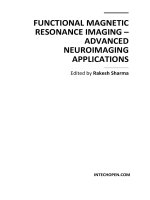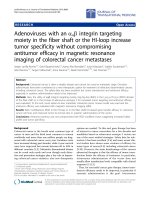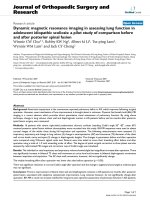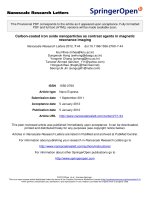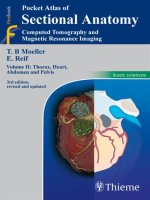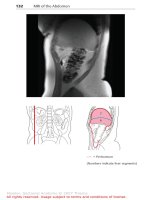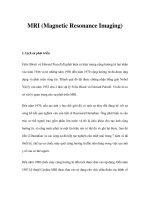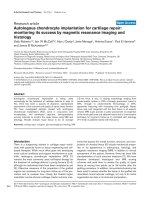Magnetic resonance imaging techniques for contrast enhanced cellular and molecular imaging
Bạn đang xem bản rút gọn của tài liệu. Xem và tải ngay bản đầy đủ của tài liệu tại đây (5.76 MB, 259 trang )
MAGNETIC RESONANCE IMAGING
(MRI) TECHNIQUES FOR CONTRAST-
ENHANCED CELLULAR AND
MOLECULAR IMAGING
PHD THESIS
GRADUATE SCHOOL OF INTEGRATIVE
SCIENCES AT THE NATIONAL UNIVERSITY
OF SINGAPORE
LEE TECK HOCK
HT061812Y
i
ACKNOWLEDGEMENTS
The past four years have been the most enlightening part of my life. Having previously
worked as a semiconductor engineer for 4 years, the plunge into biomedical research
certainly took a great leap of faith. From zero knowledge of magnetic resonance imaging to
the ability in exploiting it in the field of cellular and molecular imaging, I sincerely express
my gratitude to the following people, without whom this thesis would not be possible. First is
my supervisor Sir George Radda, who strongly supported my research and gave me the
opportunity to spend a year at his lab in the University of Oxford. That was a very fulfilling
experience, both in science and personal development. Many thanks to Professor Xavier
Golay for introducing me to MRI and the wonderful opportunities that it presents. His endless
stream of novel ideas certainly rubs off onto me. Dr. Damian Tyler led me to the exciting
world of hyperpolarized Carbon-13 and opened up opportunities for further postdoctoral
research. I also wish to thank Dr. Marie Schroeder, who was a patient mentor and Professor
Kieran Clarke for her generosity and encouragement. I am indebted to Dr Zheng Bingwen for
imparting his pulse programming skills. Last but not least, I am grateful to my fellow
colleagues at the Cardiac Metabolism Research Group (CMRG) in the University of Oxford,
Singapore Bioimaging Imagining Consortium (SBIC) at A-STAR and Center for Advanced
Biomedical Imaging (CABI) at University College London, who helped me intangibly in
these 4 years.
ii
TABLE OF CONTENTS
ACKNOWLEDGEMENTS i
TABLE OF CONTENTS ii-vii
SUMMARY viii-ix
LIST OF TABLES x
LIST OF FIGURES xi-xiv
LIST OF SYMBOLS xv-xvi
LIST OFABBREVIATIONS xvii-xviii
CHAPTER ONE
INTRODUCTION TO CELLULAR AND MOLECULAR IMAGING 1
1.1 EMERGENCE OF CELLULAR AND MOLECULAR IMAGING 2
1.2 CELLULAR AND MOLECULAR IMAGING MODALITIES 5
1.2.1 Biomarkers 5
1.2.2 Molecular Imaging Probes 6
1.2.3 Molecular Imaging Modalities 9
1.3 PHYSICAL PRINCIPLES OF MRI 11
1.3.1 Origin of MRI Signal 11
1.3.2 Proton Relaxation and Signal Attenuation 14
1.4 CHAPTER REFERENCES 19
CHAPTER TWO
DYNAMIC PERFUSION STUDY WITH T1-WEIGHTED DYNAMIC CONTRAST
ENHANCEMENT (DCE) MRI IN MOUSE PANCREAS – A POTENTIAL
BIOMARKER OF GLUCOSE SENSING
………………………………………………………………………………………… 25
2.1 OVERVIEW 26
2.2 WHY IMAGE BLOOD FLOW IN THE PANCREAS 26
iii
2.3 PANCREATIC PERFUSION QUANTIFICATION METHODS 31
2.3.1 Pancreas Morphology 30
2.3.2 Microsphere Technique for Blood Flow Measurement …………………… 31
2.3.3 Appeal of DCE-MRI in Perfusion Studies 31
2.4 PROBING OF PANCREATIC MICROVASCULATURE WITH DCE-MRI 32
2.4.1 Novelty in Mouse Pancreas DCE-MRI 32
2.4.2 Roadmap to Mouse Pancreatic Perfusion Quantification 33
2.4.3 Pharmacokinetic Modeling with DCE-MRI 33
2.4.4 Contrast Agents for T1-weighted DCE-MRI 37
2.4.5 Definition of Semi-Quantitative DCE-MRI Parameters 38
2.4.6 Pharmacokinetics of Low Molecular Weight Extracellular Contrast Agents 41
2.4.7 Dynamic T1 Quantification 46
2.5 RAPID LOCALIZATION OF THE MOUSE PANCREAS WITH MRI 49
2.6 SEMI-QUALITATIVE DCE-MRI PERFUSION STUDY IN A STAT3 KNOCKOUT
MOUSE WITH A BLOOD POOL AGENT (MS-325) 51
2.6.1 Signal transducers and activators of transcription (STAT3) Knockout Mouse 51
2.6.2 Materials and Methods 53
2.6.3 Results and Discussion 54
2.6.4 Conclusion 57
2.7 QUANTITATIVE PANCREATIC BLOOD FLOW MEASUREMENT WITH DCE-
MRI 58
2.7.1 Materials and Methods 58
2.7.2 Results and Discussion 59
2.7.3 Conclusion 62
2.8 LIMITATIONS IN DUAL COMPARTMENT MODEL, MOUSE PANCREAS MRI
AND T1 ESTIMATION 63
2.8.1 Dual-Compartment Model 63
2.8.2 Sensitivity to Contrast Agent Concentration and Precision in T1 measurements
65
2.8.3 Physiological Relevance and Validation of DCE-MRI Parameters 68
2.9 CHAPTER CONCLUSION 69
2.10 CHAPTER REFERENCES 70
iv
CHAPTER THREE
IN VIVO TRACKING OF EXOGENOUS CELL DELIVERY WITH POSITIVE
CONTRAST 79
3.1 OVERVIEW 80
3.2 TYPES OF CONTRAST AGENTS FOR CELL LABELING 81
3.2.1 T1-weighted Cellular and Molecular Targeting 82
3.2.2 T2 / T2* -Weighted Cellular and Molecular Probes 83
3.2.3 Negative Contrast Generation Mechanism with SPIOs 84
3.3 REVIEW OF POSITIVE CONTRAST TECHNIQUES FOR CELLULAR TRACKING
……………………………………………………………………………………… 87
3.3.1 Off-Resonance Imaging (ORI) 87
3.3.2 Inversion Recovery with On-Resonance water suppression (IRON) 91
3.3.3 Gradient Echo Acquisition for Superparamagnetic Particles with Positive Contrast
(GRASP) or White-Marker Imaging 94
3.4 POSITIVE CONTRAST WITH MULTIPLE-ECHOES ULTRASHORT ECHO TIME
(MUTE) 98
3.4.1 Simulation Study of Positive Contrast Enhancement with MUTE 99
3.4.2 MUTE Pulse Sequence 105
3.4.3 Radial Sampling 108
3.4.4 Non-Cartesian Regridding 108
3.5 A MULTI-ECHO TECHNIQUE FOR IN-VIVO POSITIVE CONTRAST
DETECTION OF SPIO-LABELED CELLS IN THE RAT HEART AT 9.4 T 122
3.5.1 Introduction 122
3.5.2 Materials and Methods 123
3.5.3 Results 127
3.5.4 Discussion 130
3.5.5 Limitations of Study 131
3.5.6 Conclusion 132
3.6 IN-VIVO POSITIVE CONTRAST TRACKING OF BONE MARROW STEM CELLS
WITH SUPER-PARAMAGNETIC IRON-OXIDE PARTICLES: IS BIGGER ALSO
BETTER? 133
3.6.1 Introduction 133
v
3.6.2 Materials and Methods 136
3.6.3 Results 139
3.6.4 Discussion 143
3.6.5 Limitations of Study 144
3.6.6 Conclusion 145
3.7 Z-SHIMMED ULTRA-SHORT ECHO-TIME – A NEW POSITIVE CONTRAST
DETECTION SCHEME 145
3.7.1 Z-shimmed Ultrashort Echo Time Pulse Sequence (ZUTE) 146
3.7.2 Positive Contrast Enhancement Simulation with ZUTE 147
3.7.3 Positive Contrast Comparison between MUTE and ZUTE 148
3.7.4 Results 150
3.7.5 Discussion 154
3.7.6 Conclusion 155
3.8 CHAPTER CONCLUSION 155
3.9 CHAPTER REFERENCES 156
CHAPTER FOUR
REAL-TIME DETECTION OF CARDIAC GLUCOSE METABOLISM WITH
DYNAMIC NUCLEAR POLARIZED (DNP)
13
C 163
4.1 OVERVIEW 164
4.2 PROBING CARDIAC METABOLIC ACTIVITY WITH STEADY-STATE 13C NMR
/ MRS 164
4.2.1 Low Detection Sensitivity in
13
C NMR 165
4.2.2 Hyperpolarized
13
C Compounds for Signal Enhancement 167
4.3 DYNAMIC NUCLEAR POLARIZATION (DNP) 169
4.3.1 Dynamic Nuclear Polarization Mechanism 170
4.3.2 Liquid-State DNP 173
4.4 ENERGY GENERATION IN THE HEART 176
4.4.1 Metabolic Fate of Pyruvate 178
4.4.2 NMR Spectroscopy of [1-13C] and [2-13C] – Labeled Pyruvate 180
vi
4.5 MEASURING INTRACELLULAR PH IN THE HEART USING HYPERPOLARIZED
CARBON DIOXIDE AND BICARBONATE: A 13C AND 31P MAGNETIC
RESONANCE SPECTROSCOPY STUDY 182
4.5.1 Introduction 182
4.5.2 Materials and Methods 184
4.5.3 Results 188
4.5.4 Discussion 196
4.5.5 Limitations of Study 197
4.5.6 Conclusion 198
4.6 THE DYNAMIC ROLES OF ACETYLCARNITINE IN MYOCARDIAL
CARBOHYDRATE METABOLISM: AN IN-VIVO STUDY 199
4.6.1 Introduction 200
4.6.2 Materials and Methods 203
4.6.3 Results 205
4.6.4 Discussion 208
4.6.5 Conclusion 210
4.7 INVESTIGATION OF METABOLICALLY GENERATED HYPERPOLARIZED
[1,4-13C] MALATE FROM [1,4-13C] FUMARATE AS A BIOMARKER OF NECROSIS
IN THE ISCHEMIC HEART 210
4.7.1 Introduction 211
4.7.2 Materials and Methods 212
4.7.3 Results 215
4.7.4 Discussion 217
4.7.5 Conclusion 219
4.8 REAL-TIME METABOLIC IMAGING WITH CHEMICAL SHIFT MRI 220
4.8.1 Limited T1 Lifetime of the Hyperpolarized Pyruvic Acid (CSI) 222
4.8.2 Materials and Methods 223
4.8.3 Results 224
4.8.4 Discussion 226
4.8.5 Conclusion 228
4.9 CHAPTER CONCLUSION 229
4.10 CHAPTER REFERENCES 230
THESIS CONCLUSION 236
vii
BIBLIOGRAPHY 237
APPENDIX 238
LIST OF PUBLICATIONS 239
viii
SUMMARY
In this thesis, I aimed to demonstrate the capability and versatility of Magnetic Resonance
Imaging (MRI) to perform diagnostic imaging at different physical scales, from physiological
to cellular and finally at the molecular level. Chapter 2 illustrates the ability of ‘Dynamic
Contrast Enhanced Magnetic Resonance Imaging’ or ‘DCE-MRI’ to measure an important
physiological parameter that is a biomarker of nutrient delivery, which is hemodynamic
perfusion. The use of a T1-reducing contrast agent in facilitating DCE-MRI in the mouse
pancreas is described. A mathematical approach to quantify tracer pharmacokinetics in order
to estimate blood flow is also illustrated. The competency of DCE-MRI to distinguish
between normal and angiogenesis-impaired pancreas in a STAT3 knock-out mouse model is
also be presented.
Chapter 3 ventured higher up the magnification scale into the cellular regime, whereby
cellular tracking of exogenous cells transplanted for tissue repair was visualized with positive
contrast. Superparamagnetic iron-oxide particles (SPIO) were the selected passive probes that
acted as beacons of delivered cells. The superior detection sensitivity offered by a Multiple-
Echo Ultrashort Echo Time (MUTE) MRI technique was demonstrated. In addition, I
proposed a novel method that provides robust positive contrast with high temporal efficiency
to advance cellular tracking technology. The physical principles of positive contrast sensing
and factors affecting detection sensitivity are discussed.
Finally, molecular imaging is demonstrated in Chapter 4 via the use of an avant-garde
technique that permits real-time dynamic monitoring of carbohydrate metabolism, this is
ix
‘Dynamic Nuclear Polarized
13
C Magnetic Resonance Spectroscopy (DNP-MRS)’. Here, the
biomarkers of interest were also the molecular probes themselves. They are the downstream
biomolecules of pyruvate metabolism, including [1-
13
C] lactate,
13
CO
2
, H
13
CO
3
-
and [1-
13
C]
acetyl-carnitine. In addition, the generation and utilization of these substrates were dependent
on underlying enzyme activity such as pyruvate dehydrogenase (PDH), carbonic anhydrase
(CA) and carnitine acetyltransferase (CAT). By measuring the MR signal amplitude of these
reporting probes, I was able to quantify critical biological parameters such as intracellular pH,
and track its changes at the onset of ischaemia. I also demonstrated the utilization of this
technique to study the dynamic energy storage mechanism of the heart. The potential of [1,4-
13
C] fumarate as a biomarker of necrosis in the heart was also investigated. Finally, 2-
dimensional mapping of metabolic activity was performed with chemical shift imaging (CSI).
x
LIST OF TABLES
CHAPTER TWO
2.1 Comparison of T
2
*
- and T
1
- weighted dynamic contrast enhanced MRI techniques
2.2 Semi-quantitative parameters used in the comparison of MS-325 pharmacokinetics
between wild-type mouse and the conditional STAT3-knockout phenotype
CHAPTER THREE
3.1 Contrast-to-noise ratios of injected SPIO-labeled cells in the rat myocardium
showcase the boost in positive contrast upon subtraction between a UTE image and
that of a subsequent ECHO.
3.2 Contrast-to-noise ratio comparison between IODEX-TAT-FITC and MPIO – labeled
MSCs in the rat brain
CHAPTER FOUR
4.1 Metabolite levels and kinetic parameters from
13
C MR spectra in pre-ischaemia,
reperfused and ETZ-perfused isolated hearts.
4.2 Metabolic levels and kinetic parameters from
13
C MR spectrum in pre-ischaemia,
initial reperfused and 30 min post-reperfused isolated hearts.
xi
LIST OF FIGURES
CHAPTER ONE
1.1 A spinning nucleus precessing about B
0
at Larmor frequency. (B) Effect of RF
excitation on longitudinal magnetization
1.2 Transverse relaxation effect
CHAPTER TWO
2.1 Proposed scheme for the initiation of type 1 diabetes
2.2 Signal intensity change in T1-weighted DCE-MRI of mouse pancreas
2.3 Dual-compartment model in quantitative DCE-MRI
2.4 Schematic of a typical DCE-MRI acquisition protocol
2.5 Quick MRI localization of mouse pancreas
2.6 T1-weighted DCE-MRI images of the mouse pancreas at 9.4 T
2.7 Signal intensity curve comparing tracer uptake between control and STAT3 knock-out
mice
2.8 Baseline proton-density weighted and dynamic T1-weighted MRI images acquired in
the quantitative DCE-MRI of the mouse pancreas
2.9 (A) Dynamic contrast agent concentration in the blood plasma (arterial input function),
fitted into a bi-exponential model according to eqn. (3.11). (B) Quantified
pharmacokinetics parameters blood flow F, v
p
and v
e
in the mouse pancreas
2.10 Compartmental model of DTPA tracer distribution
CHAPTER THREE
3.1 Simulation of susceptibility effect of a superparamagnetic biomarker at 9.4 T
3.2 Spatial variation in proton resonance frequency surrounding a superparamagnetic
nanoparticle. (B) Off-resonance RF excitation schematic
3.3 Proof-in-principle of off-resonance imaging at 9.4 T
3.4 Physical principle of IRON
3.5 Simulation to illustrate negative and positive contrast of a superparamagnetic marker
at 9.4 T
3.6 Negative and positive contrast of SPIOs in an excised mouse brain
xii
3.7 Simulation depicting MR signal intensity of SPIO-labeled cells and unlabeled
myocardium variation with echo-time
3.8 Schematic diagram of a MUTE pulse sequence
3.9 (A) Synchronized minimum phase SLR-VERSE excitation and slice selection
gradient. (B) Phase accrued across slice that is subsequently nulled with slice
refocusing gradient. (C) Profile comparison across a 1 mm slice between the two
excitation pulses.
3.10 2d-radial and 3d stack-of-radial sampling in MUTE
3.11 Point-spread-functions illustrate blurring of a single point in the center of image space
as a result of radial sampling
3.12 (A) Scheme of a 2D gridding procedure. The data samples lie on an arbitrary trajectory
through k-space (dashed line). The sampled data points are convolved with a gridding
kernel and resampled onto a rectilinear Cartesian grid. (B) Flow chart illustrating the
regridding process.
3.13 Effects of various terms in image regridding process given by eqn. (5.28)
3.14 Kaiser-Bessel convolution function C
KB
(k) with kernel width W
k
= 4, oversampling
ratio = 2 and free design parameter = 8.9662
3.15 (A) Voronoi diagram dividing kspace into regions that are closest to any individual
point. The inverse area associated with each sample is its weighting. (B) Calculation
of density compensation function for a projection data set
3.16 (A) UTE and (B) GRE images of the 7th frame in the cine-MRI. Regions-of-interest
are chosen at the labeled cells, unlabeled myocardium and muscle.
3.17 MUTE MRI of the excised rat heart depicting the FID, ECHO and their subtracted
images
3.18 (A) Fluorescent microscopic image of the FITC label showed the successful
transfection of IODEX-TAT-FITC nanoparticles into the bone marrow cells. MUTE
images acquired at TE = 0.3 ms (C) and 8 ms (D). (E) Subtraction between FID and
ECHO images result in higher positive contrast.
3.19 (A) Overlay between green fluorescence and bright-field optical images depicting
successful endocytosis of MPIOs into BMSCs. (B-C) illustrated the regridded MUTE
images at various echo-times (TE = 0.3 ms and 18.2 ms) while (D) displays their
subtraction.
3.20 MTT proliferation assay depicting the effect of higher MPIO labeling concentration
on cell division capability
3.21 Pulse sequence of Z-shimmed Ultrashort Echo Time (ZUTE), a hybrid between UTE
and White-Marker techniques
3.22 Simulated positive contrast achievable with Z-shimmed UTE technique
3.23 Contrast-to-noise ratio comparison between White-Marker and ZUTE
xiii
3.24 MR images comparing negative and positive contrast derived from T
2
*
-weighted
gradient echo, White-Marker, UTE and ZUTE imaging
3.25 (A) Contrast-to-noise ratio depicting the gradual increase in positive contrast as phase
within excited slice is compensated with ZUTE. (B) UTE image at = 0 and (C)
ZUTE image at = 0.2.
CHAPTER FOUR
4.1 The imbalance of spin-occupied energy states upon hyperpolarization
4.2 A schematic of the electron-nuclear transitions of the solid effect in a magnetic field.
4.3 (A) Microwave frequency sweep to identify the optimal frequency for positive
enhancement of polarization in a [1-
13
C]-pyruvic acid/OXO63/Gd3
+
sample. (B) The
corresponding polarization build-up at that frequency of 94.139GHz. (C) DNP
polarizer at the Cardiac Metabolism Research Group in the University of Oxford. To
maximize the limited lifetime of the hyperpolarized sample, the hyperpolarizer is
placed juxtaposition to the 11.7T vertical bore MRI system. (D) A typical process
flow utilizing hyperpolarized pyruvic acid as a metabolic tracer.
4.4 The three stages of energy transfer in heart muscle.
4.5 Biochemical pathways depicting the metabolic fate of pyruvate.
4.6 Changes in ATP, PCr, P
i
and pH
i
, before, during and after ischaemia.
4.7 (A) Representative spectrum acquired during hyperpolarized [1-
13
C] pyruvate
infusion into the isolated perfused heart. Five single 1 s spectra were summed to yield
this spectrum, acquired using a 30° rf pulse. (B) Changes in the metabolic products of
[1-
13
C] pyruvate in pre-ischaemic heart (n = 6).
4.8 Comparison of the time courses for the sum of the bicarbonate and carbon dioxide
peaks, normalized to the maximum value of pyruvate area.
4.9 (A) The bicarbonate and carbon dioxide, both normalized to maximum pyruvate peak
area, vs. time in control hearts (n = 6). (B) Measurement of pR based on H
13
CO
3
-
/
13
CO
2
in control hearts compared with measurement of pH
i
using
31
P MRS in the
same group of hearts. (C) The bicarbonate and carbon dioxide, both normalized to
maximum pyruvate peak area, in hearts perfused with the CA inhibitor ETZ (n = 5).
(D) Measurement of pR based on H
13
CO
3
-
/
13
CO
2
in ETZ-perfused hearts compared
with measurement of pH
i
using
31
P MRS in the same group of hearts.
4.10 Comparison of the pR measurements made in reperfused hearts using the H
13
CO
3
-
/
13
CO
2
ratio and the pH
i
measurements made using
31
P MRS
4.11 Design and results of the acetylcarnitine saturation experiments
4.12 Proposed mechanism describing the dynamics of acetylcarnitine involvement in the
glucose-fatty acid cycle
xiv
4.13 (A) Representative spectrum acquired during hyperpolarized [1,4-
13
C
2
] fumarate
infusion into the isolated perfused heart. (B) Representative time-course of [1,4-
13
C
2
]
malate before ischaemia, immediately upon reperfusion and 30mins post reperfusion.
4.14 Changes in maximum malate peak area and initial malate production rate, before
ischaemia, upon reperfusion and 30mins post-reperfusion.
4.15 T
1
measurement and flip angle calibration of sinc pulse for chemical shift imaging of
metabolites, upon dissolution of hyperpolarized [1-
13
C] pyruvate.
4.16 Metabolic time course of the infused [1-13C]pyruvate and its derivatives [1-
13
C]lactate, [1-
13
C]alanine and H
13
CO
3
-
.
4.17 Metabolic images of [1-
13
C]pyruvate, [1-
13
C]lactate, [1-
13
C]alanine and H
13
CO
3
-
in
the perfused heart along with a reference proton image.
xv
LIST OF SYMBOLS
B
0
static magnetic field strength
B
1
RF magnetic field strength
B
z,inh
local magnetic field inhomogenenity
C
e
tracer concentration in EES
C
p
tracer concentration in plasma
C
t
tracer concentration in tissue
C(k
x
,k
y
) gridding convolution function
f chemical shift
gyromagnetic ratio
G
ssr
slice refocusing gradient amplitude
tissue density
E tracer extraction fraction in tissue
F blood flow per unit mass of tissue
K
trans
volume transfer constant between v
p
and v
e
k
max
maximum range in k-space
M
0
longitudinal magnetization at thermal equilibrium
M(k
x
,k
y
) ideal continuous k-space data
M
NC
(k
x
,k
y
) non-Cartesian sampled k-space data
M
C
(k
x
,k
y
) Cartesian sampled k-space data
P polarization
pR calculated pH based on Henderson-Hasselbach equation
P
sa
point-spread function without transverse signal decay
P
blur
point-spread function with transverse signal decay
r
1
longitudinal relaxivity
r
2
transverse relaxivity
tissue density
S surface area per unit mass of tissue
xvi
S
NC
(k
x
,k
y
) non-Cartesian sampling function
S
C
(k
x
,k
y
) 2D Cartesian sampling function
S
spio
signal intensity of SPIO-labeled cells
S
ctrl
signal intensity of unlabeled control cells
noise
standard deviation of noise
t
ssr
slice refocusing gradient duration
T1W
flip angle in T1-weighted DCE-MRI
PDW
flip angle in proton density-weighted DCE-MRI
v
e
fractional volume of extravascular extracellular space in tissue
v
p
fractional volume of blood plasma space in tissue
W(k
x
,k
y
) weighting function
xvii
LIST OF ABBREVIATIONS
AIF arterial input function
ADP adenosine 5’-diphosphate
ATP adenosine 5’-triphosphate
BMSC bone marrow stem cells
CE contrast enhancement
CE
subtract
contrast enhancement in subtracted image
CNR contrast-to-noise ratio
CSI chemical shift imaging
DCE dynamic contrast enhancement
DNP dynamic nuclear polarization
DSC dynamic susceptibility contrast
EES extravascular extracellular space
EPI echo-planar imaging
ETZ 6-ethoxyzolamide
FITC fluorescein isothiocyanate
FOV field-of-view
GRE gradient recalled echo
IAUGC initial area under the gadolinium curve
IODEX dextran-coated iron-oxide nanoparticles
IRON inversion recovery with on-resonant water suppression
MPIO micron-sized iron-oxide particles
MRI magnetic resonance imaging
MRS magnetic resonance spectroscopy
MUTE multiple-echo ultrashort echo-time
NMR nuclear magnetic resonance
ORI off-resonance imaging
PHIP parahydrogen induced polarization
xviii
PCr phosphocreatine
pH
i
intracellular pH
P
i
inorganic phosphate
PSF point-spread function
RF radio-frequency
ROI region of interest
SLR shinnar le-roux
SNR signal-to-noise ratio
SPIO superparamagnetic iron-oxide nanoparticles
STAT signal transducers and activators of transcription
STZ streptozotocin
T
1
longitudinal relaxation time
T
2
transverse relaxation time
TAT transactivator of transcription peptide
TCA tricarboxylic acid cycle
TE echo-time
TR repetition time
TH tissue homogeneity model
TK Tofts-Kermonde model
USPIO ultra-small superparamagnetic iron-oxide nanoparticles
UTE ultrashort echo-time
VEGF vascular endothelial growth factor
VERSE variable rate selective excitation
WM white-marker imaging
ZUTE Z-shimmed ultrashort echo-time
1
CHAPTER ONE
INTRODUCTION TO CELLULAR AND
MOLECULAR IMAGING
2
1.1 Emergence of Cellular and Molecular Imaging
The development of life is a proficiently orchestrated process of a myriad of distinctive
molecules. From DNA to cells to tissues and organs, biomolecules are the building blocks of
all life. The ability to probe molecular and cellular processes during mammalian development
facilitates the understanding of how aberrant events can lead to disease pathogenesis (1-3).
The acme of interventional medicine is the application of ameliorative actions as soon as a
molecular aberration occurs or even before the event (4). It is optimistic that by taking such
preemptive measures, disease progression could be arrested and physiological injury could be
limited, sparing patients of unnecessary duress (5-7). Possible preventive or interventional
treatments include gene therapy whereby beneficial genes are transfected for transcription of
therapeutic proteins (e.g. SERCA2a gene therapy in heart failure to improve contractility) (8),
pharmacological inhibition of specific proteins to block deleterious signaling pathways (e.g.
inhibiting matrix metallo-proteinases MMPs to reduce left myocardium wall thinning in heart
failure) (9), or tissue repair with exogenous cell therapy (e.g. stem-cell transplantation in
infarcted myocardium) (10). With the advances in high throughput screening technology,
combinatorial drug chemistry, recombinant protein developments and availability of
transgenic models, many more therapeutic targets are being discovered at a rapid pace.
Molecular medicine is thus propelling a paradigm shift not only in the way drugs are being
developed and customized (11-14), but also the translational relationship between basic
biological research and clinical applications (15,16).
3
The pursuit of molecular medicine encompasses multiple levels of research which begins
from basic research at the bench to validation in animal models and finally translation into
the clinic. The translational researcher who carries out this arduous task is one who needs to
characterize the molecular mechanism underlying the pathology in the laboratory, devise a
method to measure that in-situ in the human disease state and develop a beneficial
intervention in the clinic (17). He or she would demand a series of imaging modalities to
visualize specific molecular and cellular interactions as well as detect physiological response
at various experimental stages (3). These imaging paradigms can be broadly categorized into
molecular, cellular and physiological imaging (3,18). Cellular imaging has in fact been
present since the invention of the optical microscope in the 17
th
century, when Robert Hooke
first described cells in a cork (19). Modern microscopes with much higher magnification and
advanced optics now enable detailed visualization of constituents in a cell as well as cellular
activity at the microscopic level. Molecular imaging on the other hand, is a contemporary
concept involving the detection of molecular events and mechanisms below the microscopic
level, encompassing processes such as metabolic activity, reporter gene expression and
enzymatic action (20). It is to be noted that visualization of a single biological process can
fall into both cellular and molecular imaging regimes. For example apoptosis or programmed
cell death can be characterized by morphological changes including plasma membrane
blebbing, cell shrinkage, chromatin condensation and formation of apoptotic bodies (21). The
visualization of such structural demise is categorized under cellular imaging. But these
permutations are initially triggered by a series of biochemical events including activation of
, which can be detected using
different fluorescent platforms (22). The apoptotic stage can be assessed by measuring
Annexin-V binding to phosphatidylserine (23,24), a protein that gets enhanced exposure on
4
the external cell membrane during early apoptosis. Visualization of such intracellular and
extracellular proteins unique to apoptosis is an application of molecular imaging.
Progress in cellular and molecular imaging is driven primarily by the following demands in
molecular medicine research (3): [1] to develop non-invasive in-vivo imaging methods that
reflect specific cellular and molecular processes, for example gene expression or more
complex molecular interactions such as proteinprotein interactions; [2] to monitor multiple
molecular events about-simultaneously; [3] to follow cell trafficking; [4] to optimize drug
and gene therapy; [5] to assess pathological progression at a molecular level; and [6] to
achieve all of the above goals in a rapid, reproducible, and quantitative manner. The
emergence of modern molecular and cellular imaging strategies can be attributed to recent
unprecedented advances in molecular biology techniques such as polymerase chain reaction
(PCR) technology (25), development of transgenic (26-28) and experimental animal models
(29,30) as well as successful implementation of small-animal instrumentation (31,32). In
addition, the nascent biomedical nanotechnology sector heralds a new paradigm in targeted
molecular imaging and therapy by increasing the availability of novel imaging probes and
drugs that are highly specific (33-36). For example engineered antibodies attached with
radio-nuclides now empower the oncologist to locate specific tumor markers in-vivo and
quantify concentration and uptake levels, boosting diagnostic precision (37,38). The
operating mode can then be switched from radiology to therapy by increasing the radioactive
dose to annihilate the tumor (39,40).
5
1.2 Cellular and Molecular Imaging Modalities
The foray into molecular medicine is a seemingly daunting task judging from the sheer
amount of biological information that has to be extracted and interpreted. As new molecular
pathways in pathology are being discovered, more specific and accurate methods of imaging
would be demanded, in order to identify potential targets for therapeutic intervention (1).
Developments in molecular and cellular imaging can be basically grouped into three
categories (41): [1] the physics and engineering of imaging techniques and instruments, [2]
the chemical and materials science needs for designing imaging probes and contrast agents,
and [3] the biological questions to be answered. It is thus appropriate here to identify the
roles of biomarkers, imaging probes and their sensing modalities.
1.2.1 Biomarkers
A biomarker is a biological characteristic that is objectively measured and evaluated as an
indicator of normal or pathogenic processes, as well as pharmacological responses to a
therapeutic intervention. Typical biomarkers are molecular in nature such as intracellular
proteins (e.g. STAT proteins) (42), surface receptors (e.g. Her2 tyrosine kinase receptor in
breast cancers) (43), metabolites (e.g. lactate) (44), mRNA expression profiles (e.g. in
) (45) or antibodies (e.g. human immune deficiency). Depending on
application, a biomarker might also be cellular morphology change or even behavioral
symptom. dopamine
producing neurons in the substantia nigra pars compacta (46,47). Molecular biomarkers of
this particular neurodegenerative disease include elevated striatal dopamine D1 and D2
6
receptors (48), increased levels of cytokines such as interleukin-1 (49) and increased iron
deposits (50). Cellular biomarkers include decreased number of dopaminergic neurons and
presence of Lewy bodies (51). Cognitive and motor impairments such as dementia (52,53),
tremor, rigidity and akinesia are some of its physiological biomarkers. Thus a combination of
biomarkers at different scales is necessary to confirm diagnosis, monitor disease progression
and assess therapeutic efficacy (54). Because a disease might have a plethora of biomarkers
which weigh differently in the diagnostic process, the National Institute of Health conjured a
classification system to optimize the use of biomarkers in the development and evaluation of
novel therapies (55). Since biomarkers are usually the intermittent or end products of a
pathological signaling pathway, they are often pharmaceutical targets as well (e.g. protein
kinases in cancer therapy) (56). Biomarkers in general play important roles in management
and treatment of pathology.
1.2.2 Molecular Imaging Probes
Molecular imaging probes, on the other hand, are molecular compounds that can be sensed by
an imaging modality. They include small molecules such as receptor ligands or enzyme
substrates, large molecular-weight affinity ligands such as monoclonal antibodies or
recombinant proteins. Molecular probes provide the imaging signal or contrast in the imaging
assays. They are usually introduced into the biological sample (serum, blood, cells, biopsies
etc) or delivered into the subject to visualize specific biological or molecular events. A
notable exception is MR Spectroscopy (MRS), where the signal derives from endogenous
molecules like
1
H,
13
C or
31
P nuclei.

